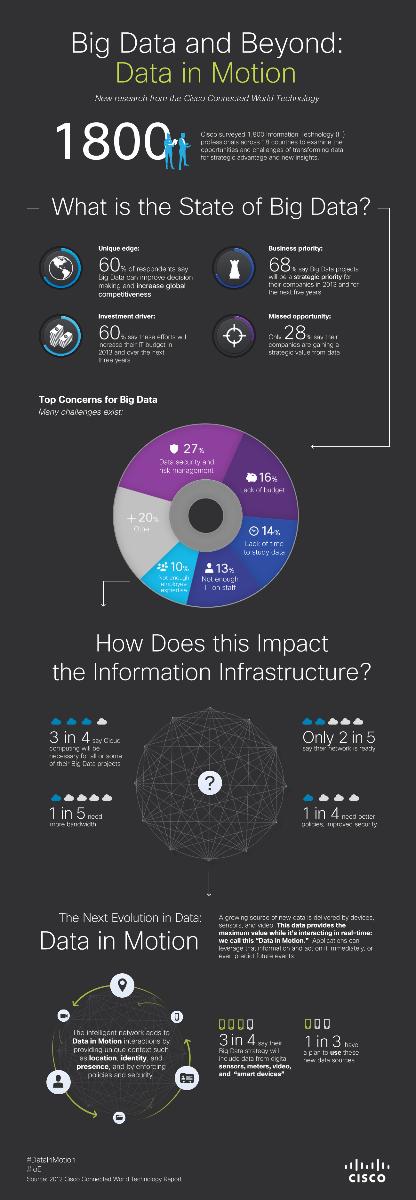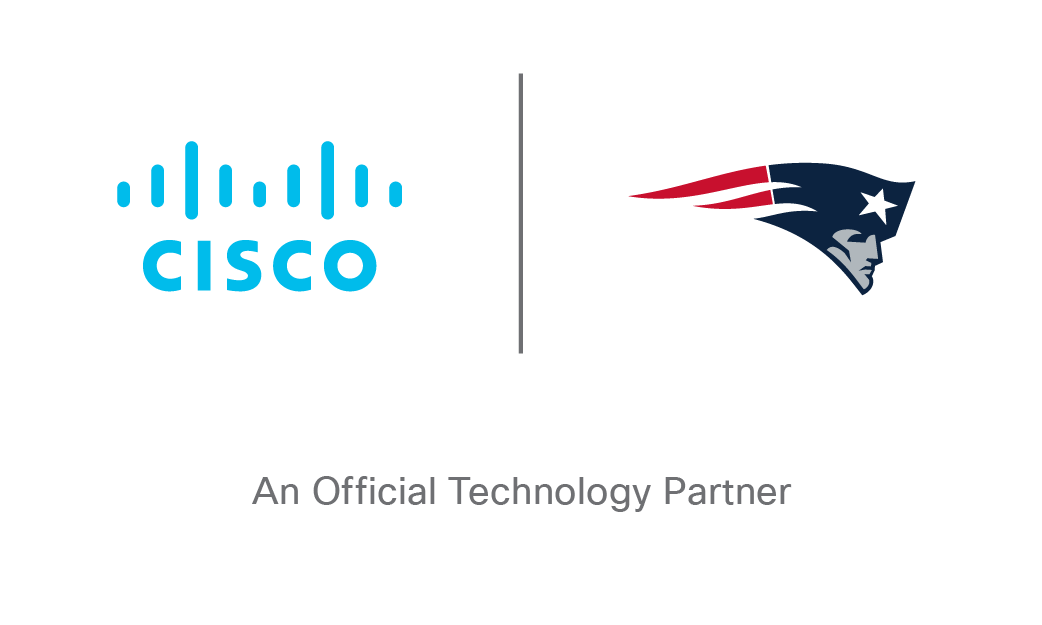SAN JOSE, Calif. – March 27 , 2013 – Enormous amounts of data are being generated daily by smartphones, sensors, video cameras, smart meters, and other connected devices, adding to the huge store of information from traditional sources. This "data avalanche" represents a potential gold mine of insights, but a new study commissioned by Cisco reveals that IT professionals and businesses are challenged to extract strategic value from their data.
The Cisco® Connected World Technology Report (CCWTR) surveyed IT professionals across 18 countries to examine the IT readiness, challenges, technology gaps, and strategic value of implementing Big Data projects.
While most companies are collecting, storing and analyzing data, the report reveals that many are struggling with both the business and IT challenges of Big Data. For example, while 60 percent of survey respondents agreed that Big Data will help improve decision making and increase their competitiveness, only 28 percent report they are currently generating strategic value from their data.
Key Findings of the 2012 Cisco Connected World Technology Report (CCWTR)
Big Data, Big Potential, Big Priority
Big Data could provide a competitive edge for those who can take advantage of data in new and creative ways.
- Globally, 60 percent of survey respondents said they believe Big Data can help businesses and countries to improve decision making and global competitiveness, with respondents in China (90 percent), Mexico (85 percent), India (82 percent), Brazil (79 percent) and Argentina (78 percent). the most confident in Big Data project benefits.
- Over two-thirds of IT managers agree that Big Data will be a strategic priority for their companies in 2013 and over the next five years as well. Scores were highest in Argentina (89 percent), China (86 percent), India (83 percent), Mexico and Poland (both at 78 percent).
- What's needed? More than a third (38 percent) say that although they have a Big Data solution, they need a strategic plan to take advantage of Big Data.
Obstacles to Gaining Insights and Realizing Value
IT managers report several obstacles to adopting Big Data solutions: Security tops the list, followed by budget and staffing.
- More than one in four respondents globally (27 percent) said data security and risk management is a major concern. They cited the sheer volume of data, the number of ways to access data, and lack of budget for security as the top reasons why securing data in Big Data projects is such a challenge.
- Security concerns were most prevalent in China (45 percent), India (41 percent), the U.S. (36 percent) and Brazil (33 percent).
- Together, lack of budget (16 percent) and lack of time to study Big Data (14 percent) are cited by a third of respondents as their main obstacles.
- Almost one in four (23 percent) said the lack of enough IT staff (13 percent) or Big Data staff expertise (10 percent) as main issues, especially in Japan (31 percent) and Brazil (30 percent).
Big Data Expected to Spur Investment in IT
More than half of the IT respondents believe Big Data will affect increase their organizations' IT budgets now and in the future based on technology, personnel and expertise requirements.
- Over half the respondents expect Big Data strategies to increase their IT budgets in 2013.
- Nearly three out of five (57 percent) say Big Data will increase their budgets over the next three years.
- Over four out of five surveyed (81 percent) said all or some Big Data projects will require cloud computing capabilities. This was especially true in China (78 percent) and India (76 percent).
- As a result, cloud adoption may affect the rate of adoption – and benefits – of Big Data efforts.
- Nearly half of IT managers (48 percent) estimated their network loads would double over the next two years, especially respondents in China (68 percent) and Germany (60 percent).
- Nearly one in four (23 percent) expect to see network loads triple over the next two years.
- Only two out five surveyed (40 percent) report they are ready for a surge in network traffic.
- Over one in four (27 percent) say they will need better IT policies and security measures.
- Over one in five (21 percent) say they will need more bandwidth.
IT Impact
Big Data expands the role of IT: More strategic, more partnership
Big Data presents an opportunity for IT to add value and create stronger relationships across lines of business that help the bottom line and increase revenue. Big Data projects can help provide opportunities for the IT department to become more of a strategic partner within their organizations.
- Not surprisingly, three out of four respondents (73 percent) said that the information technology department will drive their Big Data strategy. However, survey respondents said other lines of business will join IT in Big Data leadership, including: Finance (24 percent), Research and Development (20 percent), Operations (20 percent), Engineering (19 percent), Marketing (15 percent), and Sales (14 percent).
- In Argentina, a high percentage (58 percent) said Finance will help drive Big Data.
- In China, a large number (61 percent) said Research and Development as well as Engineering (47 percent) will help lead Big Data.
Big Data and IT staffing
Many companies are discovering that Big Data projects need to span multiple lines of business requiring new levels of intercompany collaboration. And while technology is important to Big Data solutions, people are needed with the special skill set and creativity to imagine and realize data's full potential. There is a growing need for more IT professionals to be trained in this specialized area: for example, the "data scientists" who transform raw data into information leading to discovery and insight, communicate what they've learned in creative and visual ways, and suggest business impact.
- Almost one in four IT managers (22 percent) say Big Data projects will significantly affect IT staffing, and over half (56 percent) say it will have at least some impact.
- When asked if they were personally ready to take advantage of Big Data opportunities, 35 percent felt unreservedly ready, 36 percent expressed their readiness but felt the technologies and solutions were lacking, and one out of four (24 percent) did not feel ready at all.
Data in Motion: new data source leads to new opportunities
An important, but largely untapped, type of data is the real-time actionable data generated by sources such as devices, sensors and video, which often provide the most value while interacting in real time: Cisco calls this Data in Motion. The network can provide useful contextual information to Data in Motion such as a person or device's location, identity and presence (whether they are "available" or not). This data can be used by applications to make decisions or take actions that are immediately relevant, or even to predict future events. Machine-to-machine communication in factory automation is an example where Data in Motion could be extremely valuable in optimizing a production process. According to the Cisco Visual Networking Index Global Mobile Data Traffic Forecast for 2012 to 2017, there will be more than 1.7 billion machine-to-machine connections by 2017.
- Three out of every four respondents (73 percent) plan to include data from digital sensors, smart meters, video, and other nontraditional networked "smart devices" into their Big Data plans.
- Adoption is in the early stage: Only one-third of survey respondents globally (33 percent) have a plan in place to take advantage of these new data sources.
- The exceptions are China (64 percent), India (59 percent) and Argentina (50 percent), where IT managers report their companies have already implemented plans to use these new data sources.
The data deluge: Where is all that data coming from?
Many types of information are collected and/or used today, including both structured and unstructured data.
- Survey respondents cited these data sources as the most common for their companies:
- 74 percent are gathering current data.
- 55 percent have collected historical data.
- 48 percent bring in data from monitors and sensors.
- 40 percent take advantage of real-time data that is used and then discarded. Countries with a much higher usage of real-time data were: India (62 percent), the U.S. (60 percent) and Argentina (58 percent).
- 32 percent are collecting unstructured data, such as video. At 56 percent China is well above the global average for gathering unstructured data.
About the Study
The third in an annual series, the 2012 Cisco Connected World Technology Report, was commissioned by Cisco and conducted by InsightExpress, an independent market research firm based in the United States. The global study consists of two surveys: one focused on college students and workers aged 18 to 30, and the second focused on IT professionals. Each survey includes 100 respondents from each of 18 countries: United States, Canada, Mexico, Brazil, Argentina, United Kingdom, France, Germany, Netherlands, Russia, Poland, Turkey, South Africa, India, China, Japan, South Korea, and Australia.
Gen Y Study
The first study in the 2012 Cisco Connected World Technology Report (CCWTR) found that 90 percent of Gen Y surveyed worldwide said they check their smartphones for updates in email, texts, and social media sites, often before they get out of bed, The report examines how Generation Y uses the Internet and mobile devices to connect with the world around them, and the enormous amounts of data being generated daily by smartphones, sensors, video cameras, monitors, and other connected devices.
SUPPORTING RESOURCES
- Visit website: Cisco Connected World Technology Report
- View animated video: Potential and Challenge of Big Data
- View video: Data in Motion: the Next Evolution of Data
- Learn more: The Internet of Everything
- Learn more: Data in Motion
- Learn more: Big Data
- Learn more: Mobility
- Learn more: Cloud
- Discover "What is your data footprint"
- View video: Gen Y and Technology
- Read Cisco Blogs
About Cisco
Cisco (NASDAQ: CSCO) is the worldwide leader in IT that helps companies seize the opportunities of tomorrow by proving that amazing things can happen when you connect the previously unconnected. For ongoing news, please go to http://thenetwork.cisco.com
# # #
Cisco and the Cisco logo are trademarks or registered trademarks of Cisco and/or its affiliates in the U.S. and other countries. A listing of Cisco's trademarks can be found at www.cisco.com/go/trademarks. Third-party trademarks mentioned are the property of their respective owners. The use of the word partner does not imply a partnership relationship between Cisco and any other company.








